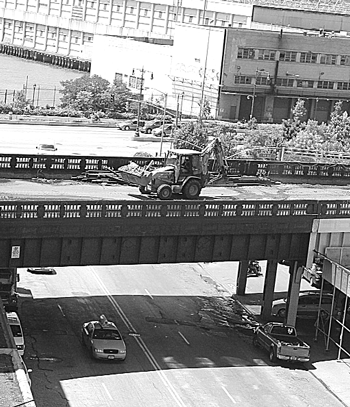By Albert Amateau
The Dia Art Foundation and the Bloomberg administration are in the midst of complex negotiations for a new Dia museum to be built on city-owned property at the proposed Gansevoort St. entrance of the High Line, the derelict railroad viaduct being transformed into a 1.5-mile-long elevated park.
The foundation, which has its permanent collection in Beacon, N.Y., intends to replace its Chelsea exhibit space on W. 22nd St. with a new facility along Gansevoort St. connecting to the viaduct. Under the plan, part of the area beneath the museum would still be used by meat businesses.
“The city wants this to work,” said Janel Patterson, a spokesperson for the city Economic Development Corporation. “E.D.C. and other city agencies are working to refine a viable project acceptable to all the parties,” she added.
“We think Dia will be a great fit with the High Line,” said Joshua David, co-founder of Friends of the High Line, the civic group involved with the city in building the elevated park, starting at Gansevoort and ending at 33rd St., where the former rail line dips down below grade.
“The negotiations are moving slowly but with no lack of enthusiasm,” said Laura Raicovich, deputy director of Dia Art Foundation.
The plan is for Dia to move to a new two-story concrete building on the north side of Gansevoort St. between Washington and West Sts. The building would include the 100-foot-wide southern entrance to the elevated park. Dia’s main gallery would be on the second floor with direct access to the High Line, and its ground-level space would be for sculpture too large to move to the second floor.
The 35,000-square-foot museum would share the city-owned block with a meatpacking co-op. The square block has a deed restriction dating back to when the Astor family gave it to the city with a mandate for use as an agricultural market. The restriction would have to be modified and a special permit would be needed to allow a museum on the site.
In addition to Dia and the city’s High Line Park project, the other parties involved are meat wholesalers who still do business in the Gansevoort Market District and may want to lease space beneath the museum’s western end.
Some ground-floor space in the new Dia museum will be used for High Line maintenance and operations, according to a spokesperson for the Department of Parks and Recreation, which will run the High Line as part of the city parks system.
Meanwhile, the first construction phase of the Gansevoort-to-20th Sts. segment of the High Line Park is underway. It involves lifting and removing the rails to a storage area further north on the High Line, removing the ties and the rock ballast and repairing the drainage system of the viaduct that was built more than 70 years ago to carry New York Central freight trains that had previously run on the surface of 10th Ave.
In the second construction phase, the rail bed will be rebuilt and new plantings, paths, lighting and access stairs and elevators will be installed. The project is being designed and coordinated by Field Operations and Diller Scofidio + Renfro. Piet Oudolf, a horticulturist from Holland, is directing the plantings that will resemble the wild flowers and grasses that have been wind sown on the High Line since 1980 when the rails last brought three carloads of frozen turkey to the Gansevoort Market.
If all goes according to plan, the southern section of High Line Park will be open in the spring of 2008.
The new Dia museum, which will feature special temporary exhibits each on display for about a year, is expected to open later, Raicovich said.





































